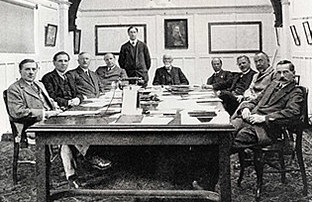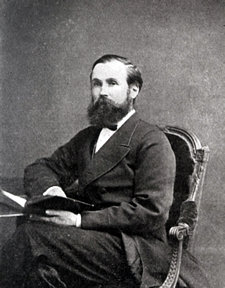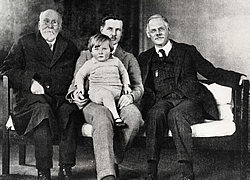1900s
| |
1904 The Joseph Rowntree
Village Trust (now the JRF) is established in December.
1904 Between 1904 and 1919, 229 houses are built
in New Earswick, to designs by Raymond Unwin.
1907 In New Earswick, the Folk Hall is built and
the first Village Council established.
|
|
1910s
1910 The Foundation gives its first
grant to a housing body, the National Housing Reform Council, a
national organisation concerned with improving housing conditions.
1919 The Foundation gives its first support
to the Garden Cities and Town Planning Association (later the Town
and Country Planning Association). |
1912 New Earswick
Primary School opens, with an innovative open-air design.
1919 Barry Parker becomes consultant architect
for New Earswick in 1919, remaining so until his death in 1946.
A further 259 homes are built between 1919 to 1936. |
|
1920s
| |
1926 On the death
of Joseph Rowntree, building work starts on Clifton Estate beside
his old home in an attempt to spread further the design principles
behind New Earswick. |
|
1930s
| |
1935 The Foundation
is a founder member of the National Federation of Housing Societies
(now the National Housing Federation).
1936 When Seebohm Rowntree, Joseph’s son, retires
from York, the Foundation purchases his house, The Homestead (now
the JRF headquarters). The gardens become a public park, still maintained
by the Foundation through the JRHT. |
|
1940s
| 1946 Concerned by the
effect of family breakdown on community life, Trustees support projects
working with ‘problem families’. |
1941 A secondary school
opens in New Earswick.
1942 Louis de Soissons is appointed consultant
architect in New Earswick; he remains so until 1962.
1944-1954 The Foundation helps fund the City of
York plan.
1946 A new phase of building starts in New Earswick;
104 homes are completed by 1954.
1948 An extensive modernisation programme begins
on individual houses in New Earswick.
1948 The New Earswick Nature Reserve is developed
on the site of the old brick works. |
1946 12 older peoples’
cottages, with a retired nurse on call for emergencies, are the
first form of care service offered in New Earswick. |
1950s
1959 A private Act of Parliament
changes the trust deed to enable the Foundation to support research
into housing and social questions.
1958-63 The Rowntree Trust Housing Studies, directed
by David Donnison, mark the first major programme of research work.
1959 Substantial funding of a programme at the
Institute of Community Studies marks the beginning of work on family
and community life.
|
1950 The White Rose
estate programme in New Earswick begins; providing more varied accommodation,
the programme continues throughout the decade.
1958 Joseph Rowntree’s old home, Clifton Lodge,
is converted into flats. |
1951 Conversion of
a former farmhouse, The Garth, in New Earswick, provides permanent
accommodation for older people, with two resident staff. |
1960s
1960 With a grant of £100,000, the
Foundation joins with the Joseph Rowntree Charitable Trust
and the Joseph Rowntree Reform Trust in supporting
the foundation of the University of York.
1961 A long-term programme of support begins for
the National Institute for Social Work Training (subsequently NISW).
1964-67 Pearl Jephcott’s study of high-rise living
examines its affect on family life.
1964-69 The Foundation provides funding to establish
the Institute of Social and Economic Research, University of York.
1965 Peter Townsend’s major work on poverty in
York begins. It is published in 1979. |
1960 The ‘Swedish
flats’ for single people are built in New Earswick.
1962 Ray Fraser becomes the Foundation’s consultant
architect.
1965 The Ouse Lea estate is built in York as an
experiment in co-ownership housing.
1967 New Earswick Swimming Pool opens.
1968 The New Earswick Folk Hall is extended and
modernised.
1968 The Riseborough House flats are built in the
grounds of Clifton Lodge.
1968 The Joseph Rowntree Housing Trust
is formed as a legally separate housing association.
1968 In New Earswick, the Village Council is reconstituted
as a community association with 25 members, the New Earswick Village
Association. |
1960 Building work starts
on Garth Court; this extension to the Garth allows residents to
look after themselves, taking their midday meal in the Garth dining-room. |
1970s
1971 The Foundation establishes the
Centre for Studies in Social Policy, with funding of £120,000. This
later becomes the Policy Studies Institute, following a merger with
Political and Economic Planning.
1974-78 Together with the Carnegie United Kingdom
Trust, the Foundation supports the Wolfenden Inquiry into the future
of voluntary organisations.
1976-87 Philip Abrams’ work begins, examining what
promotes or deters ‘neighbourliness’ and informal care.
1977 J A Heady publishes his evaluation of the
Foundation’s policy and practice in selecting and supporting social
research.
1977 E M Goldberg undertakes a pragmatic study
of the effectiveness of social care.
1978 Following the publication of the Wolfenden
report, the Foundation supports the establishment of social action
centres in several towns.
1978 John Greve begins a major study of sheltered
housing and its links with other services for older people. He reports
in 1981.
1978 Mervyn Murch begins a ten-year programme of
work on divorce procedure and family law.
1979-84 Anchor Housing Trust launches the Staying
Put initiative, in conjunction with the Foundation, to help older
owner-occupiers stay in their own homes.
1979-84 Alice Coleman examines the influence of
estate design on vandalism.
1979 With a growing number of projects, the Foundation
starts to divide its research work into defined programmes. |
1970-79 After surveys
of village opinion, the East side of New Earswick is modernised,
with new roads, pedestrianisation and the systematic reconstruction
of house interiors.
1971 Maple Court flats replace older houses demolished
in Station Avenue.
1973 The JRHT adopts the fair rents system.
1979 – The New Earswick Village Association
is reconstituted as a 12-member Village Council, following the recommendation
of the Adams Report.
1979-82 The Foundation undertakes a scheme of urban
renewal, improvement for sale and sheltered housing at Clementhorpe
in York. |
1972 The Foundation
accepts responsibility for managing The Family Fund, giving grants
to the families of severely disabled children.
1977 Red Lodge opens in New Earswick, providing
residential care and a day centre for thirty older people. |
1980s
1980-90 The Policy Studies Institute
begins a major investigation of the social security system, which
concludes in 1990.
1981 Trustees establish a special programme on
‘Mental Handicap’. This develops into a fuller programme on issues
relating to disability.
1985-87 New work begins on Community Care, Special
Needs Housing and Tenant Participation.
1986 The first Director of Research is appointed,
taking on responsibility for research management from the Trust
Director.
1986-91 Duncan Maclennan directs a £2m research
initiative into Housing Finance.
1988 A programme of work on improving relations
between Local and Central Government begins.
1988 Projects on homelessness become important
segments of the Foundation’s housing research, together with continued
work on tenure issues, such as private renting, mortgage interest
tax relief, mortgage arrears, and negative equity.
1989 The Foundation’s publication programme begins
with the first issues of Search and Findings.
|
1982 The Foundation
wins a High Court case determining that Leasehold Schemes for the
Elderly are charitable housing.
1985-87 The first ‘flexible tenure’ scheme is opened
at Dower Court, York. Further schemes with alternative tenures are
opened at Heslington, Sturdee Grove and Upper Poppleton in York,
and at Danes Dyke and Woodlands Vale in Scarborough.
1987 Shared ownership is introduced for the 21
homes completed at Woodlands Place in New Earswick.
1987 A new doctors’ surgery is built in New Earswick.
1988 The UK’s first ‘mixed tenure’ scheme is pioneered
at Juniper Close, New Earswick, with homes available for renting,
shared ownership and outright sale.
1988 The Friends Meeting House opens in New Earswick.
1989 Building in New Earswick continues with flats
and houses at Alder Way and Hazel Close, available under ‘flexible
tenure’.
1989 Rowntree Wharf opens; the former Rowntree
plc warehouse in the centre of York is converted into flats and
offices.
1988-93 The JRHT forms a three-way partnership
Hull Churches and Sadeh Lok Housing Associations to build schemes
in Hull, Huddersfield and York. |
1984 In partnership
with MENCAP, a hostel is opened at Dormary Court.
1984 Red Lodge is extended, with 33 new flats offering
sheltered accommodation.
1989 Fledglings’ Court opens in Market Weighton,
providing a permanent home for thirteen adults with learning difficulties.
1989 Sandacre Court opens offering sheltered accommodation
on a flexible tenure basis. |
1990s
1991 The Duke of Edinburgh’s
Inquiry into Housing is published, providing a major review
of the availability and condition of British housing.
1991 The social research programme is reorganised
to separate Social Policy from Community Care and Disability. Development
projects also start to receive increased emphasis.
1992-94 A major programme, again directed by Duncan
Maclennan, looks at the role of housing in the British economy.
1992-95 The JRF Inquiry into Planning for Housing
begins; its report is published in 1995.
1993 Building for communities by David
Page highlights the need for balanced sustainable communities in
social housing.
1994 The Family and Parenthood programme begins.
1995 The JRF Inquiry into Income and Wealth highlights
increased inequality in the distribution of wealth in the UK.
1995 The Area Regeneration programme commences
with the publication of Unleashing the potential, covering
over 100 housing estates.
1996 The JRF Inquiry into Meeting the Cost of Continuing
Care reports.
1996 A seminar at Leeds Castle considers ‘Local
Government in the 21st Century’.
1997 The Foundation launches Communities That Care
(UK), a new community-based programme that aims to reduce risks
for children and families.
1998 The first JRF Summer School is held for future
leaders of the voluntary sector.
1998 The JRF Department of Policy and Practice
Development is established, to take forward the messages from research.
1999 Building Regulations are amended, introducing
lifetime home requirements. |
1990 The JRHT establishes
a housing welfare advice service.
1990 Increased residents’ representation on JRHT
Committees strengthens tenant participation.
1994 JRHT opens Woodlands – the first estate in
the UK built entirely to ‘Lifetime Homes’ standards.
1995 ETHOS (Existing Tenants Home Ownership Scheme)
is launched; this is later replaced by the Government's Voluntary
Purchase Grant scheme.
1997 The JRHT appoints a Community Development
Worker and Family Support Worker.
1998 The New Earswick Residents' Forum and New
Earswick Community Association are established. |
1991 Lamel Beeches residential
accommodation for older people opens in York, built jointly with
The Retreat hospital.
1991 Flexible care and new warden control are introduced
at Red Lodge.
1993 A second hostel, Charles Court at Strensall,
is built in partnership with MENCAP.
1993 The JRHT pioneers the ‘dependency scoring’
system of care assessment.
1994 Accommodation for people with cerebral palsy
opens at Alder Way, New Earswick.
1996 The Family Fund is established as a separate
charity.
1996 Alder House opens in New Earswick. Developed
in conjunction with the York and District Cerebral Palsy Society,
it provides accommodation for ten residents with physical disabilities.
1997 The first students receive the JRF Certificate
in Care, developed to equip staff with the changing skills required
in Care Homes of the future.
1998 Residents move into Hartrigg Oaks, the UK’s
first continuing care retirement community. |
2000s
2000 With new systems of devolved
government, the Foundation appoints Advisers on taking its research
forward in Scotland and Wales.
2001 A report looking at ‘Drugs: Dilemmas, Choices
and the Law’ calls for a more constructive debate on drugs policy.
2002 100 years after building work starts at New
Earswick, the Foundation holds a Centenary Housing Conference, chaired
by HRH The Duke of Edinburgh. The conference sees the launch of
the JRF Land Inquiry which raises key issues concerning the supply
of land for housing.
2002 The first Policy and Practice Development
programme on Neighbourhoods begins.
2003 Tackling disadvantage: A twenty-year enterprise
considers what steps will be needed to ensure the poorest groups
in society achieve a fairer share of the nation’s growing prosperity.
2003 Five new research programmes are launched,
covering migration, the governance of public services, drugs and
alcohol, independent living and differences in parenting.
Find out more about the Foundation’s
current research priorities and how it is working to effect
change. |
2000 The first CASPAR
schemes – City-centre Apartments for Single People at Affordable
Rents – are opened in Birmingham and Leeds, to encourage young
professionals into the inner cities.
2001 Housing Operations staff move to converted
offices at The Garth, in the heart of New Earswick.
2002 Agreement is signed for the purchase of land
at Osbaldwick from City of York.
2003 The JRHT deposits an Outline Planning Application
for a proposed new community of 540 homes to the east of York, on
the land west of Metcalfe Lane.
Find out more about New
Earswick and the Joseph
Rowntree Housing Trust. |
2000 In the Hartigg
Oaks Lecture, Sir Stewart (now Lord) Sutherland warns that extra
resources announced by the Government to meet the care needs of
older people are ‘likely to offer only a short-term and partial
solution’.
2002 Building work begins at Bedford Court, Leeds,
an innovative, purpose-built care complex for older people. Bedford
Court opens on 12 January 2004.
Find out more about the JRHT’s care
services. |
|



